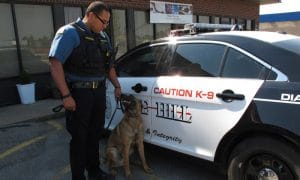K-9 Unit Joins Police Force

Article courtesy of the Rose Hill Reporter.
A new Rose Hill Police Force K-9 Drug Dog Unit of Officer Deshaun Smith and K-9 Officer Urlo has been deployed in Rose Hill. The K-9 unit will be a welcome addition to the police force.
He also just graduated from Emporia State University in May with a Bachelor’s degree in Sociology and minor in Crime and Delinquency Studies and Criminal Justice.
Officer Urlo is an 18 month old Belgian Malnois, from the Netherlands, the same breed as his predecessor Linda, who has retired with Bob Sage. He has completed all of his formal training and is a fully certified drug dog, just as Smith is a fully certified canine handler.
Becoming certified was no easy task. Smith is both a husband and father, and the training took him away for four weeks to Shallow Creek Kennels in Sharpsville, PA. Course study began in the classroom with basic canine first aide. This included ingestion of the drugs and overdoses, checking for pulse and heart rate, and medicines they are allowed at the veterinary clinic. The history of the various dogs involved, which also included Labradors and German short hair pointers among others, were studied to learn behavioral and characteristic traits of their dogs.
Case laws were studied that stated when and how a K-9 unit could legally be used in any given situation.
Basic field training was applied before meeting their canine partners. Leash handling and walking the dog on a leash may sound simple but it was much more complicated. Officers were taken on dry runs through large buildings and taught how to break it down into sections for recognizance. Single room searches and car interiors required different tactics. Even walking the dog around a suspect car was a regimented routine.
Handlers had to recognize when their dog caught the “odor.” At that point during the search leash control was very important so the line was not pulled tight which would indicate the dog should cease his “sniff” and follow his handler instead of continuing the search. Handlers learned to “present” where they wanted the dog to search by putting their hand in a specific spot.
Tracking or person searching was another aspect of training. Handlers created a “sent pad” by scuffing the ground hard and dragging their feet in a path that had twists and turns. The dog would sniff the scent pad and follow that scent to end where the dog was rewarded with his toy. The handler must know the dog’s behavior to determine if he was “on track.” Different leash controls had to be learned for each separate situation as it was a form of command.
Evidence and article search send the dog to a specified area to recover an item it could take officers hours to find in a field, for instance a discarded murder weapon that had been discarded.
Voice commands did not depend on words but rather the tenor of the command. Praise tones were used in play activities in a high pitch. Actual command tones and correction also had to be differentiated from basic obedience commands which are given in Dutch. This is for safety sake.
K-9 units are trained in an atmosphere of distractions that includes nearby food, gun shots, loud noises, trains and anything that might deter their focus while working.
“The most difficult part of training was the physical and mental demands. You are up and down and in and out with the dog, being alert to his behavior and making the appropriate commands and corrections. It really surprised me,” stated Smith. “He is a furry five year-old in training.” Handlers must also be aware of their dog’s energy levels and of over-commanding.
Both Smith and Urlo were apprehensive at their first meeting as they assessed one another for strengths and weakness. “Then he just jumped up and started licking me. It was really great,” he said with a twinkle in his eye. “That was the beginning of the bonding.”
The training never stops. “Everyday is a training day,” Smith said. They also train regularly with other K-9 units in Butler County and across the state.
Urlo is a full-time partner and family member and is always with Smith at home and on patrol. The new squad car came with special modifications. A temperature controlled heat alarm alerts Smith on the interior car temperature and the windows automatically roll down and fans kick in. The horns begins to honk and sensors go off to alert Smith.
There is no back passenger area, it is a steel enclosure with a rubber mat and grilled windows for safety. A sliding door between the front passinger area allows Urlo to stick his head through for a front row view out the window.
The K-9 Unit will work with Student Resource Officer Matthew Neal when his presence is needing in the schools or for training purpose. The team deployed at the high school before summer break.
Officer Urlo is trained to detect marijuana, heroine, methamphetamines, cocaine, and any derivatives of these drugs. “I think it is a huge asset to the city and the department. Rose Hill has a definite drug problem. A K-9 Unit works as a deterrent making the city safer and keeping drugs out of town. They see the dog’s presence and think twice before they commit a crime here,” stated Smith. city and the department. Rose Hill has a definite drug problem. A K-9 Unit works as a deterrent making the city safer and keeping drugs out of town. They see the dog’s presence and think twice before they commit a crime here,” stated Smith.

WOW !!!! very interesting post .brilliant, thank you so much. I like your post.